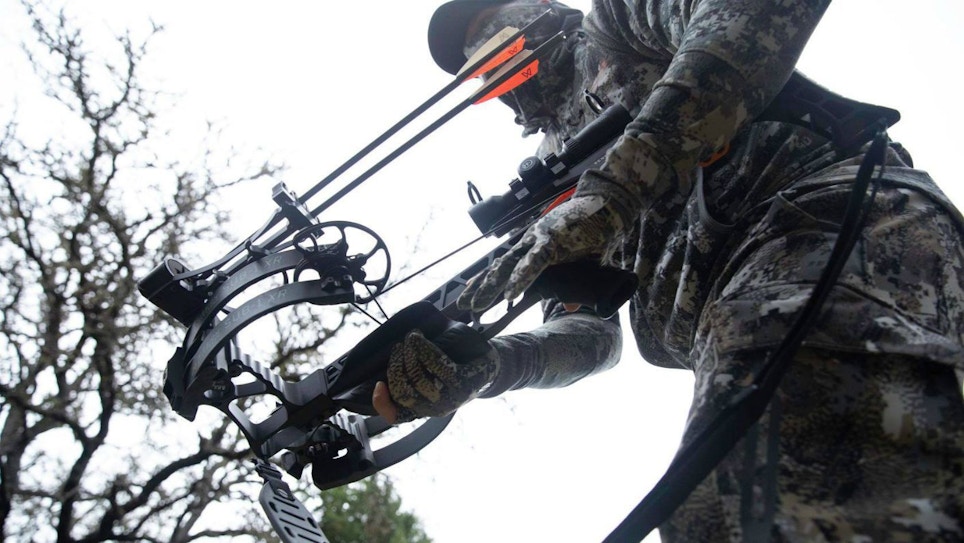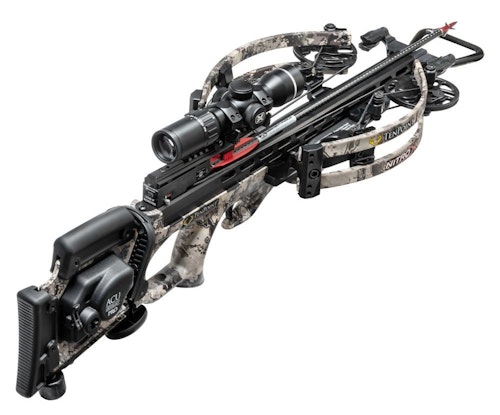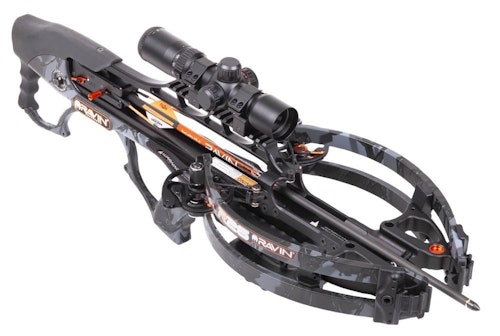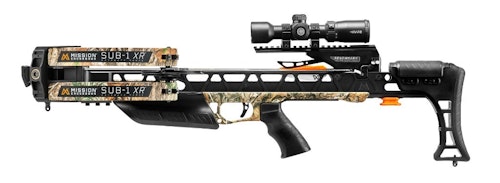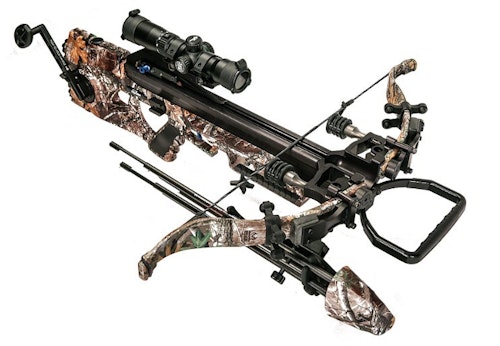For those who used to watch the sitcom Home Improvement with Tim “the Tool Man” Taylor, you can undoubtedly hear his grunts of delight and enthusiastic cry for “more power,” if he was to look at and describe the modern crossbow. The best way to describe these new horizontal bows is that speed can be converted into power.
At this year’s Archery Trade Association Show, TenPoint introduced the Nitro XRT, a reverse-draw bow, shooting a blistering 470 fps with 191 foot-pounds of kinetic energy. The big news last year was TenPoint’s Stealth NXT, with a conventional draw, it produced speeds up to 410 fps with a potential of 144 FP/KE.
Ravin Crossbows introduced its R26 this year, which shoots up to 400 fps and is the narrowest cocked bow on the market at a mere 5.75 inches. The new Mission SUB-1 XR delivers speeds up to 410 fps, and for those who like the recurve limbs, Excalibur introduced the Assassin 420 TD shooting, as the name suggests, 420 fps.
Have you seen a crossbow ad that didn’t focus on its speed? What does it mean for hunters?
Set Limits
Hunters need to set their range limit before heading to the field in search of a worthy big game animal. Variables in the field are what dictate success — and sometimes failure.
Last fall, while hunting pronghorns in Wyoming, I learned why setting a range limit is still critical to success. It was a beautiful, calm day, something a little unusual for the open Wyoming grasslands. Calm days are the ones that can cause a crossbow hunter heartache. A mature, beautiful buck came into the watering hole I was watching; the buck stood facing me while slurping in a day’s supply of cool, refreshing H2O. When the buck finished drinking, he quickly turned and trotted to the top of the bank on the far side of the water. I knew the buck was just over 40 yards, so I held my crosshair for a heart shot. When the buck lowered his head to rake his horns in some sagebrush, I let my arrow fly. Even with his head down, rubbing vegetation, the buck heard my crossbow and immediately spun to run away. My arrow did not pass through the animal’s heart, but it did penetrate the shoulder and killed the animal cleanly.
My Wyoming adventure was the first realization of the speed advantage of my TenPoint Stealth NXT. Shooting at 410 fps, my arrow took flight, passing through the buck — even though he jumped the string — causing a fatal wound. If I had been shooting a slower bow, my arrow would have likely hit paunch; or it might have flown right over the animal, as it ducked and spun.
I have always set a 50-yard limit when crossbow hunting. There is too much that can go wrong in a fraction of a second to justify taking longer shots; it’s risky business. I’d bet the pronghorn I shot would not have jumped the string if there was wind to help cover the noise of the crossbow. However, the new speed bows have changed my view on the maximum range. The extra speed will allow crossbow hunters to shoot 60 yards without having to worry about a critter jumping the string, under optimal conditions.
Speed offers an advantage when it comes to aiming points. When forced to make quick decisions in the field, one often must guess or judge the distance quickly. With the speed of the new crossbows, distance reticles are closer together than ever. Some of the new crossbows I’ve shot could be zeroed at 30 yards, as there was little difference in arrow trajectory between the 20- and 30-yard targets. That said, the trajectory of the arrow dropped fast after 40 yards, which is how crossbows will always function.
Build Confidence
Shooting a crossbow long range is fun; if you haven’t tried it, you should. Hitting targets with accurate results can be exhilarating. It is a confidence builder to place a three-arrow group in a bull’s-eye circle at 80 to 100 yards. It is a great way to learn and understand trigger control. One wrong move and your arrow may not even find the target at the extreme range.
The best part about shooting long distances is it will make you a better shot when you’re shooting under 40 yards. The concept isn’t new to archery, and I regularly do the same with my vertical bows to get in hunting shape, conditioned for making killing shots. Crossbows shooting at 100 yards shouldn’t surprise anyone, as vertical archers have been doing it for years.
British longbows were used in battle for centuries and proved war-changing long-range weapons. Medieval bows required 80 to 130 pounds of draw force and took years for soldiers to master. Bowmen often had enlarged shooting arms from practicing with their bows, building the muscle required to do it with consistent accuracy. It’s hard to know for sure, but it’s thought that the longest arrow flight from a longbow was about 400 yards. In 1542, King Henry VIII set a minimum practice range for his bowmen of 200 meters or 220 yards. The history lesson is a bit of a revelation when trying to put crossbows into perspective with modern technology.
If longbows were shooting up to 400 yards in the 1500s, one would expect a crossbow in 2019 to be able to hit a target at 100 yards. The main difference was that longbows were used to shower arrows on their enemies, hoping that some of them would find their way into opposing soldiers, and they did. Hunters want to be precise and consistent and hit their prey with deadly accuracy instead of blind luck.
Speed and Energy
The principles of archery remain the same no matter how much technology improves our equipment. Arrows, limbs and strings all have limitations. The time it takes for an arrow to find the target is important. The trajectory of your arrow over distance needs to be known and understood. The fact you know a target isn’t going to move is the biggest difference between hunting and playing at the range. When you factor in the limitations and unknown variables an animal can throw at you, a crossbow is still a 60-yard tool when it comes to hunting with even a modern bow.
The last thing to consider when it comes to arrow speed and hunting is the total weight of your projectile. A heavier broadhead and arrow can be a huge advantage to hunters, as it eats up much of the noise created when a crossbow transfers energy to an arrow. A heavier broadhead and arrow combo has better penetration; thus carries more energy, which is beneficial to all hunting. With the incredible speed produced from modern crossbows, try creating an optimized energy solution, it might just be a game changer this fall.
